This portfolio of 10 original compositions explores the song cycle through the incorporation of a wide variety of stylistic elements. The cycle is unified in its incorporation of elements borrowed from contemporary and popular styles of (guitar) music and expresses contemporary realities from a personal perspective in the smallest event interaction. (see here)This forms the precedence by which popular styles of music are incorporated into a song cycle. The compositions are experimental without denial of narrative structure shared by the free improvisers.
Although the lyrical subject matter of each song varies from one to the other throughout this cycle, the authorship of both music and lyrics by the composers lends an overall sense of conceptual unity. The compositions feature notated solos for classical guitar players and traditional classical or jazz ensembles.
Composition Descriptions

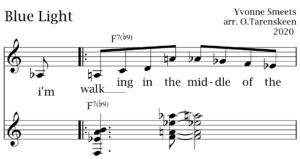
In Blue Light, the title song of the CD, the linear movement of the guitar part leads on a functional level and it is pivotal to the progression of the harmonic language. Yet more importantly it conveys a quintessential characteristic of jazz and blues style. One of the two original compositions of the portfolio in swing style groove, changing in the middle section to classical ostinato.
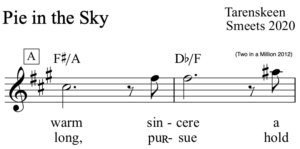
In Pie in the Sky style elements are used that don’t really belong in vocal popular music such as the F# against the F in the bass as a result of slash chords combined with ‘straight eight’ and swing grooves. There is a free counterpoint collective improvisation in the middle section on a imaginable pedal bass tone. The instrumental solo version was called ‘Two in a Million’.
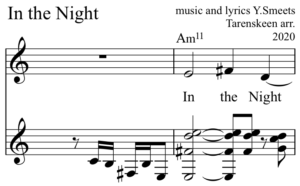
In the Night, is based on a slow straight eigth groove refering to the ballad popsong almost bossa nova but then with irregularity of rhythm (pattern). The groove based on thumb technique, plays rhythm, pressed – or open string bass pedal tones, irregular with on top polyphonic triads.The chords appear on ‘on’ and ‘off’ beats with damping techniques chord with cluster sounds; tones in the high register in combination with open strings. Overdubbed Ambient sounds divide different intersections.
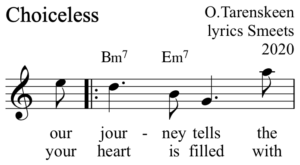
Choiceless A-part starts out as a Song ending with an interlude as transition to the B-part
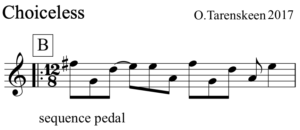
Choiceless B-part continues with a minimalistic structural expansion and reduction, as well as ostinato or looping patterns; ostinato phrase becomes something of a ʻhookʼ that structurally brings the song together, as well as contributing to its overall harmonic function. Finally the song ends with the reprise of the A-part in 12/8 meter
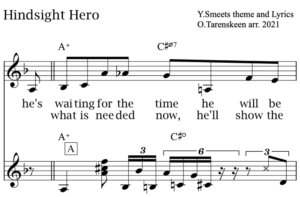
Hindsight Hero – theme and collective improvisation, ʻfolk-likeʼ vocal tone, blatant example in its indication of scat vocal improvisation in the middle of the song. Another distinctive vocal inflection by drawing on the iconic sound of blues tonality.
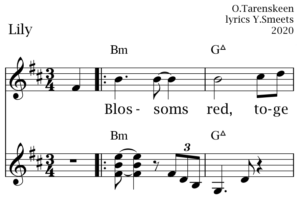
Lily, a fast waltz with an intervening guitar-bass part wereas the two bass strings of the guitar are digital processed to an octave lower. From the song collection, in this song, the highest range of the voice is used in contrast with bass and interior chords of the guitar in counterpoint with the voice. The guitar part is played on a Godin nylonstring guitar.
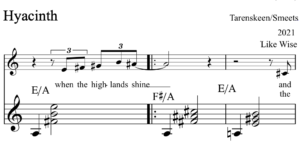
In Hyacinth we hear the pace of an art music Waltz were in the melody the A#vocal note is combined with an A bass note as a result of slash chords.
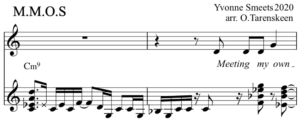
Meeting My Own Standards, a piece with several layers of ambient sounds, digital percussion and overdubbed guitar solo and voices in a ‘streight eights funky groove’. Followed by a contrapuntal improvisation between voice and single note guitar playing as middle section.


Renaissance Woman, originally composed as an instrumental piece titled ‘5 percent of anything’. The second piece in a swing groove harmonised with tertian related chord sequences. The vocal line starts out with halfnotes singing ‘Wander and search for Wonder‘ followed by ‘thats what you need’ ..as allusion to traditional swing rhythm patterns. The piece extends with a collective solo unit contrasting the arranged unison rhythm B-part.
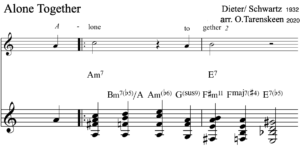
Alone together highlights the use of a string of ʻtwo-five-oneʼ (ii-V-I) cadences and the way it is varied in harmonic colour through chord substitution, fingerstyle, contemporary guitar textures(see video lecture), both of which are key aspects of jazz harmonic style and Transmutation of the Classical Guitar